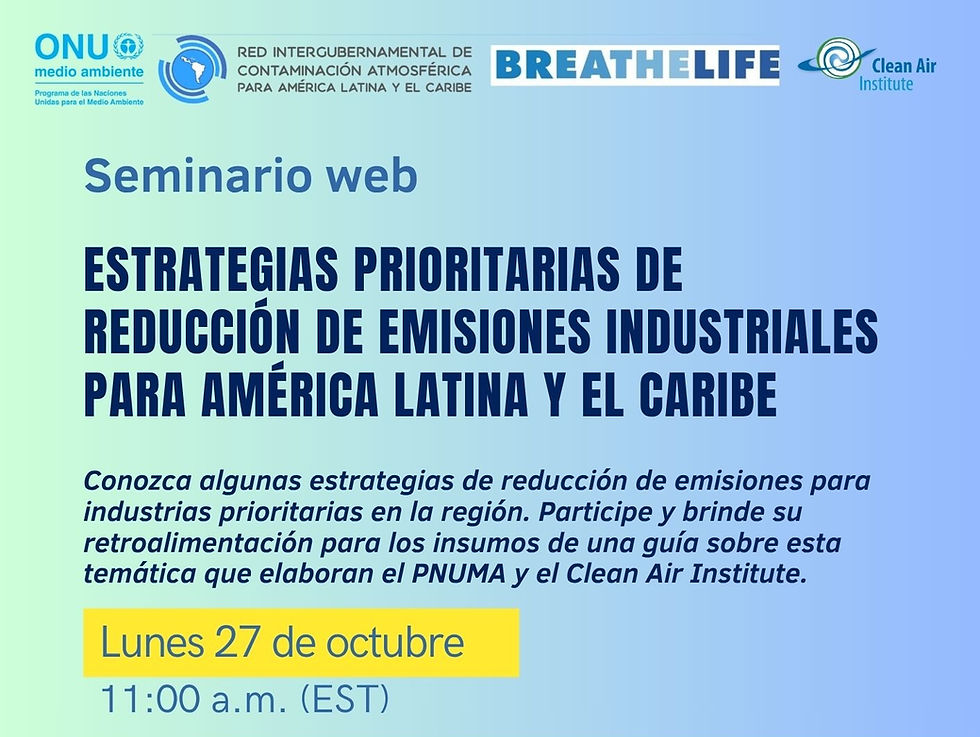Advancing Air Quality, Climate, and Health objectives in Central America and Dominican Republic
- mcardenas882
- Dec 3, 2024
- 4 min read
Updated: Dec 4, 2024
A collaborative success story
The project “Advancing Regional Air Quality, Climate, and Health Objectives in Central America”, funded by the Climate and Clean Air Coalition (CCAC), which constitutes the first phase of implementation of the Integrated Roadmap on Air Quality, Short-Lived Climate Pollutants and Health, has successfully concluded.
Central American states are situated in a relatively small strip that naturally connects the Americas, while the Caribbean, specifically on the island of Hispaniola, is home to the Dominican Republic. All these countries are rich in biodiversity, with beautiful coasts along on both the Atlantic and Pacific Oceans, as well as a varied topography of mountains, volcanoes, valleys, and plains. The total population of the eight countries that make up the region is just over 60 million inhabitants. The main sources of energy include hydroelectric power, fossil fuels, and biomass. The region is highly vulnerable to the effects of climate change and faces challenges, such as deforestation, pollution, and biodiversity loss. Due to its relatively small size, the impacts of air pollution from transportation, burning, volcanoes, marine aerosols, and Saharan dust often have transboundary effects.
Jair Urriola Quiroz, Executive Secretary of the Central American Commission on Environment and Development (CCAD), commented: “Climate change is a reality, and its effects are already being strongly felt in our region. Air quality, for example, is affected by the new climate variability, which increases dry seasons and wildfires. While our countries have developed initiatives to improve air quality, we still face many challenges ahead. We have established a strong alliance for clean air, which has undoubtedly been successful, and we continue working within the framework of the Roadmap derived from this joint program. For our environment ministers in the SICA region, this issue is of utmost importance, which is why, during the last Pro Tempore Presidencies, significant efforts have been made to advance this process within the intersectoral agendas of the Environment, Health, and Agriculture sectors of SICA”.
Dr. Alejandra Acuña Navarro, Executive Secretary of COMISCA, highlighted the project as a distinctive and invaluable opportunity for the health and environment sectors to establish a joint platform to promote impactful actions to reduce air pollution and its associated health risks.
Key Achievements of the project
Carlos González, Project Coordinator and Environmental Quality Advisor for the CCAD Executive Secretariat, highlighted this project has delivered valuable resources to improve air quality, mitigate climate change, and protect public health in the SICA region, and shared the key outcomes, including:
Strengthened Legislation: A Regional Air Quality, Climate, and Health Legislation Guide was developed to drive regulatory updates, grounded in a thorough assessment of existing legislation.
Outputs on air quality, climate, and health legislation (Spanish).
Enhanced Monitoring: A transformative Regional Atmospheric Monitoring Strategy was developed, offering a comprehensive roadmap for obtaining continuous and reliable air quality data. And a game-changing customizable monitoring station prototype, adaptable to the unique needs of each country, has been created to significantly elevate and strengthen ongoing monitoring efforts.
Air quality monitoring outputs (Spanish).
Capacity Building: a powerful capacity-building initiative was implemented, delivering both in-person and virtual training sessions covering key topics such as regulation, air quality management, and health benefits. These comprehensive trainings empowered over 46 technical officials from the environment and health sectors of the eight countries in the region (28 women and 18 men), equipping them with the knowledge and tools to drive impactful air quality improvements and safeguard public health.
Strategic Action Prioritization: Through the guided virtual course “Integrated Management of Air Quality and Health” on PAHO's Virtual Public Health Campus, participants designed and prioritized strategic actions to combat air Pollution and climate change and protect public health, culminating in strategic posters for each country.
Juan José Castillo, Air Quality and Health Advisor for PAHO noted the course’s success in uniting environmental and health sectors: “It represents the first joint intersectoral effort at the regional level, providing a clear roadmap for immediate action”.
Prioritized interventions identified by member states.
Health Benefits
Román Cordero, the Coordinator of the Project Portfolio Unit for the Council of Ministries of Health of Central America and the Dominican Republic Executive Secretariat (SE-COMISCA), emphasized a significant finding: with the support of the Clean Air Institute and PAHO tools, countries in the SICA region estimated that meeting the WHO global air quality guidelines could prevent over 20,000 premature deaths. This critical data serves as a driving force for advancing regulatory updates and improving air quality across the region.
Health benefits estimation from regulatory improvement (Spanish).
A Collaborative Approach
Juliana Klakamp, Chief Operating Officer at the Clean Air Institute emphasized the project’s participatory approach, which was key to ensure alignment with the needs of both sectors. The active involvement of CCAD and COMISCA’s Executive Secretariats played a pivotal role in maintaining high engagement levels throughout the process.
Celebrating Success
The project's results were showcased during the virtual event “Clean Air Now: Strategic Actions on Air Quality, Climate, and Health in Central America and the Dominican Republic” on September 6, 2024, in honor of the International Day of Clean Air for Blue Skies. Key speakers, including Dr. Alejandra Acuña Navarro, Executive Secretary of COMISCA, Eng. Juan Bello from UNEP and Dr. Gerry Eijkemans from PAHO, praised the collaboration that led to effective strategies for improving air quality and public health.
Representatives from Nicaragua, the Dominican Republic, and Honduras presented their strategic actions, reinforcing the region's commitment to integrated management of air, climate, and health.
Luisa González from the United Nations Environment Programme (UNEP), highlighted that this project exemplifies the growing leadership of Central America and the Dominican Republic in addressing these critical issues through intersectoral collaboration, as well as the importance of the regional cooperation among countries with similar challenges.
The project was implemented by the Clean Air Institute with support from the Pan American Health Organization, the United Nations Environment Programme (UNEP), and the Executive Secretariats of the Central American Commission on Environment and Development (CCAD) and the Council of Ministers of Health of Central America and the Dominican Republic (COMISCA). This project was funded by the Climate and Clean Air Coalition, a UNEP convened initiative to mitigate short-lived climate pollutants.




























Comments